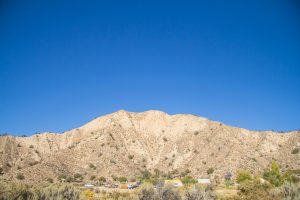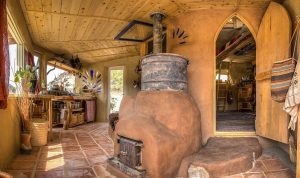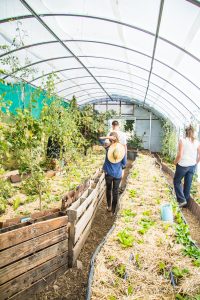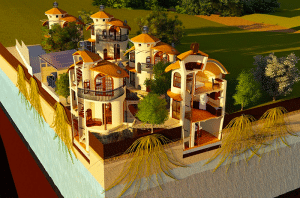BY SAM WATERSTONE | February 25, 2020
On the edge of our county, located in a quiet canyon of the Cuyama Valley and surrounded on three sides by the Los Padres National Forest, an environmentally-focused nonprofit is advocating for a different type of solution to California’s housing crisis.

Quail Springs provides direct programming and maintains an ecologically regenerative human settlement in the high-desert. At their property in the Cuyama Valley, a group of dedicated educators, farmers, and natural builders are exploring ways to utilize sustainable and regenerative design to meet our community’s basic needs for shelter, water, food, and energy.
While sustainable design seeks to reduce negative impacts on the environment, regenerative design goes one step further by actively restoring and revitalizing ecological systems – a concept that is central to the work being done by the team at Quail Springs.
Quail Springs offers a variety of hands-on courses, including a Permaculture Design Certification Course, a Sustainable Vocation Training Program, and Natural Building Courses, among others. They also run youth programs designed to encourage students from across the county to engage with the natural environment.
“We do a lot of youth and adult programming,” said Sarah Brooks, Co-Executive Director at Quail Springs. “We advocate for natural building, drylands farming, and watershed restoration. Overall, our goal is to provide education that empowers people to live in a regenerative way, in relationship with the land.”
With local government and nonprofit agencies looking for creative ways to address the ever-growing need for affordable housing, Quail Springs is advocating for natural building as one of the solutions to this crisis. Currently, they are working on a major campaign to legalize natural building. Natural building (also known as “monolithic adobe” or “cob” building) combines clay, sand, straw, and water, and is hand sculpted to form structures such as walls, ovens, and fireplaces. According to Quail Springs, natural building makes use of “readily available, affordable, nontoxic materials to build beautiful, organic, fire-resistant structures.”

Indigenous people all over the world have been building homes out of the earth for thousands of years. Today, 30% of the earth’s population lives in earthen homes. In the Spanish colonial period, adobe brick homes were the dominant form of housing in the City of Santa Barbara, and many of the original adobe buildings remain standing to this day. In fact, prior to moving to 1111 Chapala Street, the Santa Barbara Foundation was located at the Hill-Carrillo Adobe for many years.
Natural buildings cost about as much to construct as conventional buildings. However, the economics of this building system have the potential to be very beneficial for local communities.
“Expenses are much more labor-related and less in the building materials, which makes it a really appropriate building system for communities that have a lot of labor and not a lot of money,” said Sasha Rabin, Natural Building Director and Board Director at Quail Springs.

The legalization of natural building could create more workforce housing and more jobs for local workers, while reducing the amount of carbon dioxide released by building conventional houses.
The United Nation’s Global Status Report 2017 states that “buildings and construction together account for 36% of global final energy use and 39% of energy-related carbon dioxide (CO2) emissions” when the production of energy is included. Natural building, on the other hand, uses much less energy and releases dramatically less of the harmful greenhouse gases that contribute to climate change, according to Rabin.
Perhaps the most compelling argument in favor of natural building is that these structures are noncombustible and nontoxic, as opposed to conventional wood-framed structures that are highly combustible and contain toxic chemicals. In recent years, California has experienced a significant increase in urban wildfires that threaten lives, damage property and release huge amounts of carbon dioxide into the atmosphere. A solution to the affordable housing crisis that emphasizes fire safety and environmental sustainability could be a game changer.
Quail Springs’ campaign to legalize natural building has already delivered promising results. They have developed earthquake-safe adobe designs, and formed a partnership with Cal Poly San Luis Obispo to conduct official earthquake testing on these designs. They are also raising funds to conduct testing for an official fire rating.
The organization has used its power as a convener to form a coalition of building officials, architects, academic researchers, builders, engineers, and activists. This group has successfully removed many regulatory barriers to natural building by advocating for building code reform on the local, state and national levels.
One member of that coalition is Art Ludwig, a Santa Barbara-based integrated design consultant and policy advocate who works closely with Quail Springs.
“So far as I can tell, Quail Springs is the highest-potential site for doing permitted collaborative research on climate-safe, sustainable, and affordable building,” said Ludwig. “It is one of few sites in Southern California where the exceptionally flexible Limited Density Rural Dwelling Code applies. We can stand there side-by-side with the chief building official, develop an innovative design, get a permit, build and test it with a fraction of the time and cost needed under regular code.”

Ludwig is working alongside local government officials and organizations like Quail Springs to build collaborative solutions to the major issues facing our communities. He has developed a pilot project to build five cob micro-units in downtown Santa Barbara to demonstrate how natural building and integrated design can help achieve the city’s sustainability and affordability policy goals.
“We believe that there should be an accessible way for all of us to provide sustainable forms of shelter for ourselves and our families – as we have throughout human history – and not have so many people living on the street. Our current system for housing is just not working,” said Rabin. “It’s time to rethink this.”
The Santa Barbara Foundation has supported Quail Springs Permaculture through two Small Capacity Building Grants awarded in 2018 and 2019. Small Capacity Building Grants are investments in organizational capacity and programmatic effectiveness of organizations, like Quail Springs, that are dedicated to creating strong, vibrant, and inclusive communities throughout Santa Barbara County.
Learn more about Quail Springs Permaculture at quailsprings.org.